With the price of food, shelter, and gas consistently on the rise over the past year, inflation is stressing people out across the country. But how far are Americans willing to go to save money? We discovered that 50% of Americans are currently willing to move across the United States in an effort to save money on housing.
Additional Key Findings:
- 46% of Americans believe Southern states offer the most attractive cost of living.
- When considering the distance they’d prefer to go, 68% would want to make an in-state move only
- Some 9% have moved to a more dangerous area in order to save money due to inflation, while 10% have relocated to a less expensive area.
- Baby boomers are the least likely generation to relocate across the country, with 80% refusing.
- Safety around the new home and neighborhood is the highest priority to consider when deciding where to live for 19% of Gen Z and 19% of Millennials.
- Only 24% of people are unwilling to consider moving to a less expensive area.
- 42% of Gen Xers refuse to part with anything they own when moving to save money.
50% of Americans Willing To Consider Moving Across the Country To Save Money
Survey findings revealed a 50/50 split among all participants when asked if they would move across the country to save money. In total, 520 of the 1,035 (50%) people surveyed indicated that they were open to the concept.
When we look at the breakdown of those who said they were willing, 20% said they “definitely would,” and 30% said they “probably would.” And among the unwilling, 21% said they “definitely would not,” and 29% said they “probably would not.”
No Cross-Country Move Plans for 80% of Baby Boomers
We examined these results based on age and discovered that Baby Boomers (those over the age of 60) seem largely unaffected by inflation and have very little interest in moving. Some 80% of them said they would stay put, leaving only 20% willing to relocate.
Seniors’ reluctance to move a great distance — even with the promise of savings — may not be surprising, as relocation stress syndrome and transfer trauma have been documented among older adults transitioning from their homes to long-term care facilities. While a cross-country move does not directly imply a move into a senior care facility, the potential risks for heightened stress during a move are worth considering for older adults.
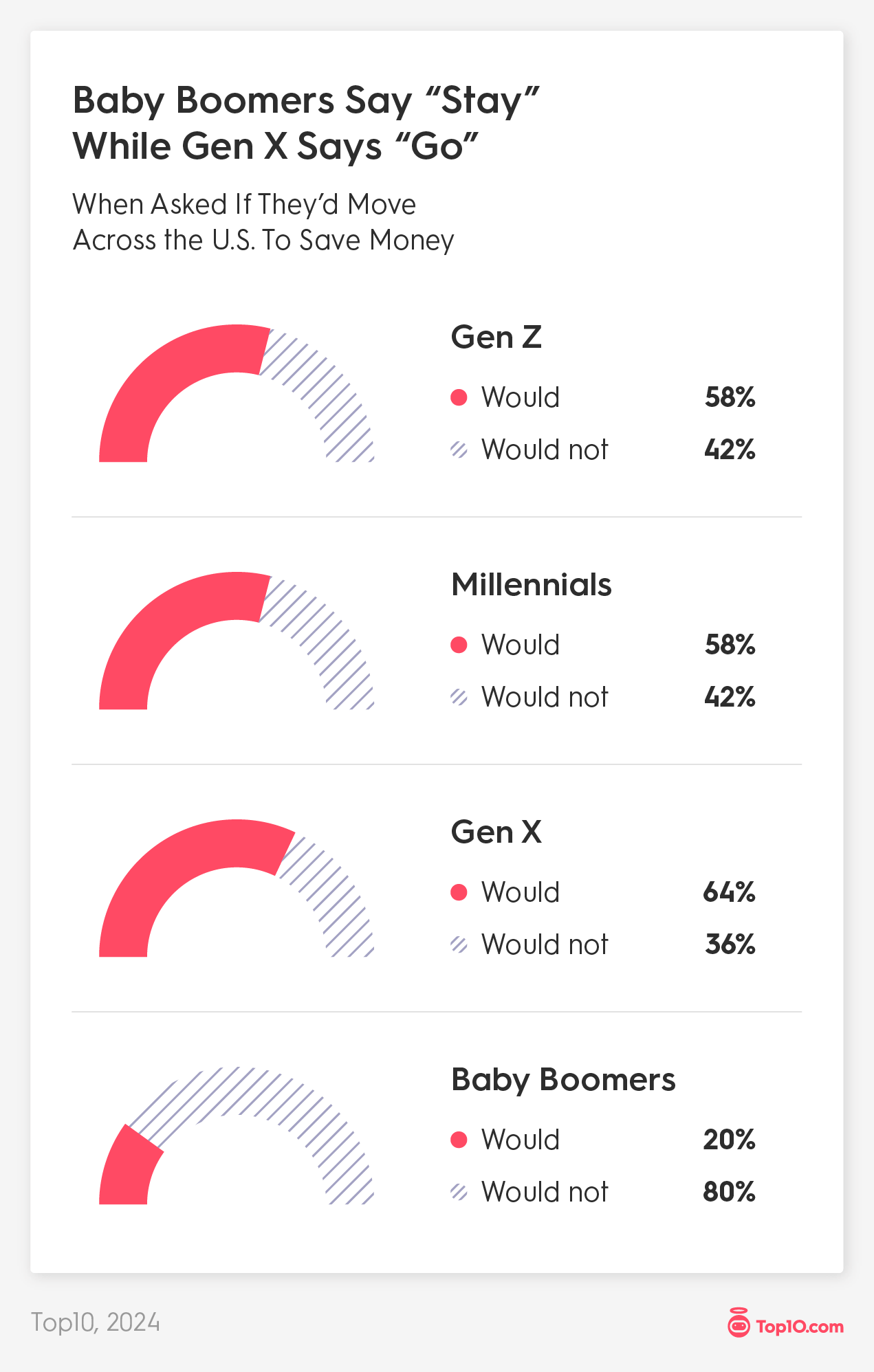
Younger generations are almost three times more likely than older adults to move across the country to save money. Gen X, adults between the ages of 45-60, are the most into the idea of making the move, with 64% saying they would either definitely or probably do it. Gen Z (adults ages 18-29) and Millennials (those ages 30-44) weren’t far behind, with 58% of each demographic willing to make the move.
46% Say the South Offers the Best Cost of Living in 2024
Perspectives on the cost of living can shift during tough economic times. We asked people to tell us which region of the country they believe offers the best cost of living, and, spread among three key regions, the American South came out on top.
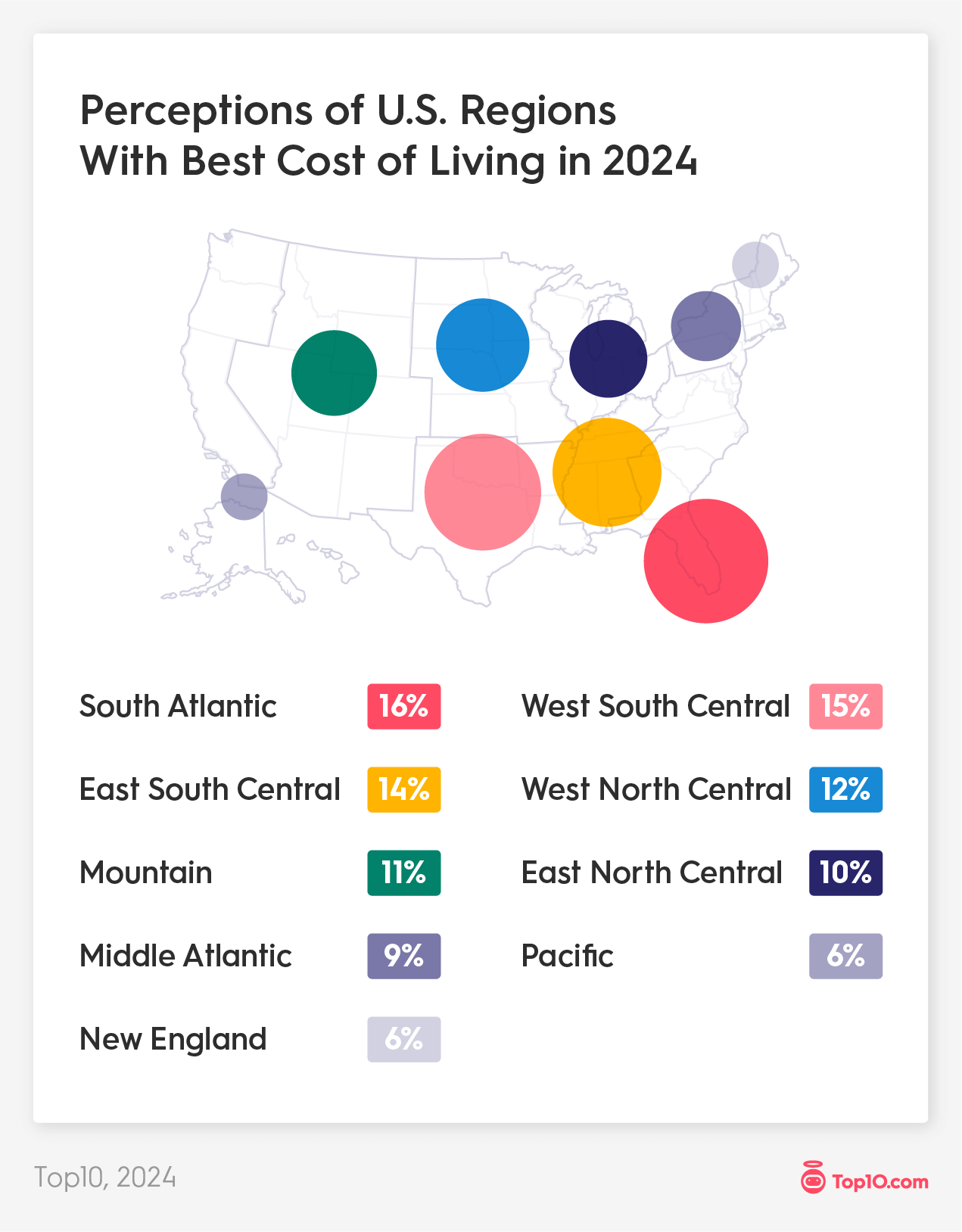
Some 46% of Americans identified a southern region as the most economically friendly place to be in 2024. The area known as the South Atlantic, comprising Florida, Georgia, North Carolina, South Carolina, Virginia, and West Virginia, earned 16% of the vote.
The four states in West South Central (Arkansas, Louisiana, Oklahoma, Texas) also garnered 16%, while the East South Central states of Alabama, Kentucky, Mississippi, and Tennessee earned 14%.
These results are even more interesting when we compare them to the actual cost of living data from the Missouri Economic Research and Information Center.
As shown in the chart below, while the Americans surveyed believe that the South Atlantic states offer the lowest cost of living in the country, that region actually ranked 5th. Perceptions of affordability clearly don’t align with economic data, as the region falls below the halfway point in terms of the cheapest cost of living.
| Region | Perceived Lowest Cost of Living Rank | Actual Lowest Cost of Living Rank |
|---|---|---|
| South Atlantic | 1 | 5 |
| West South Central | 2 | 2 |
| East South Central | 3 | 1 |
| West North Central | 4 | 3 |
| Mountain | 5 | 6 |
| East North Central | 6 | 4 |
| Middle Atlantic | 7 | 7 |
| Pacific | 8 | 9 |
| New England | 9 | 8 |
As we continued to explore the public’s view of regional affordability, we also asked if they believed their current home location was affordable. The most common response was “somewhat affordable,” accounting for 41%. Around thirty-five percent said their current area is “affordable,” and 24% said it was not affordable.
68% Willing to Move Within Their State, But No Further
The general public was also asked how far they would be willing to move to lower their cost of living. Nearly 70% were willing to only relocate within their current state of residence. Of those, almost one in five said they’d only move within city limits, with another 14% saying they’d consider staying within county limits.
We were surprised by where Americans want to move to—14% are willing to head toward their state’s rural areas as a money-saving option. Thirteen percent said they’d consider moving to suburban cities within their state, while another 13% said they were willing to relocate to a new state within their current region.
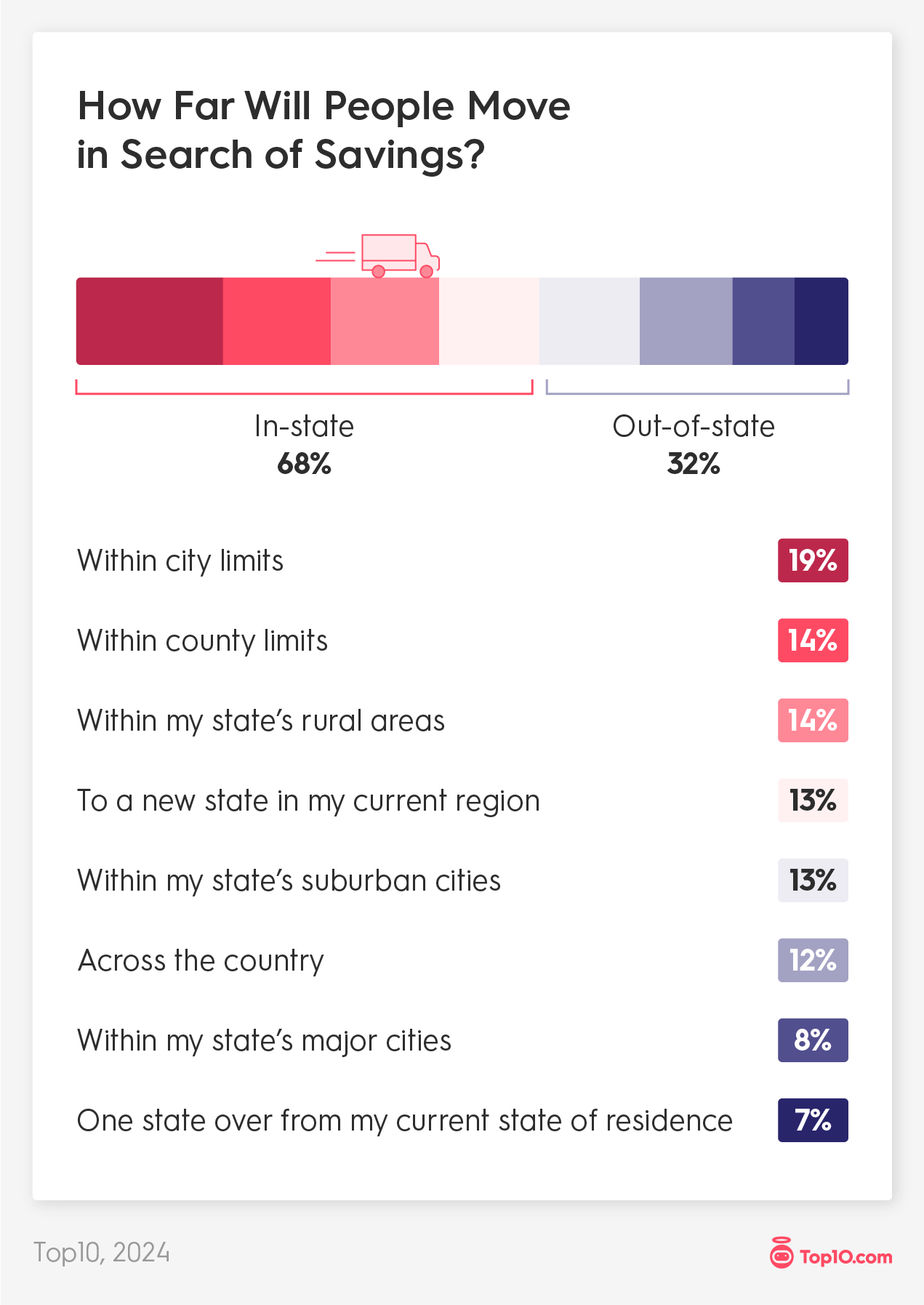
When asked if they’d tried certain money-saving tactics due to a higher cost of living, we found that inflation has already led one in ten people to move to another part of the country with a lower cost of living. And 9% of people have made the difficult decision to relocate to a more dangerous local area to decrease their housing costs.
More Than Half of Americans Saving Money By Eating Out Less to Fight Inflation
Drastic moves aren’t the only methods Americans are using to combat the increase in daily living expenses. Over 50% say they’re now eating out less often, while 41% said they’ve opted to switch to cheaper brand alternatives when shopping.
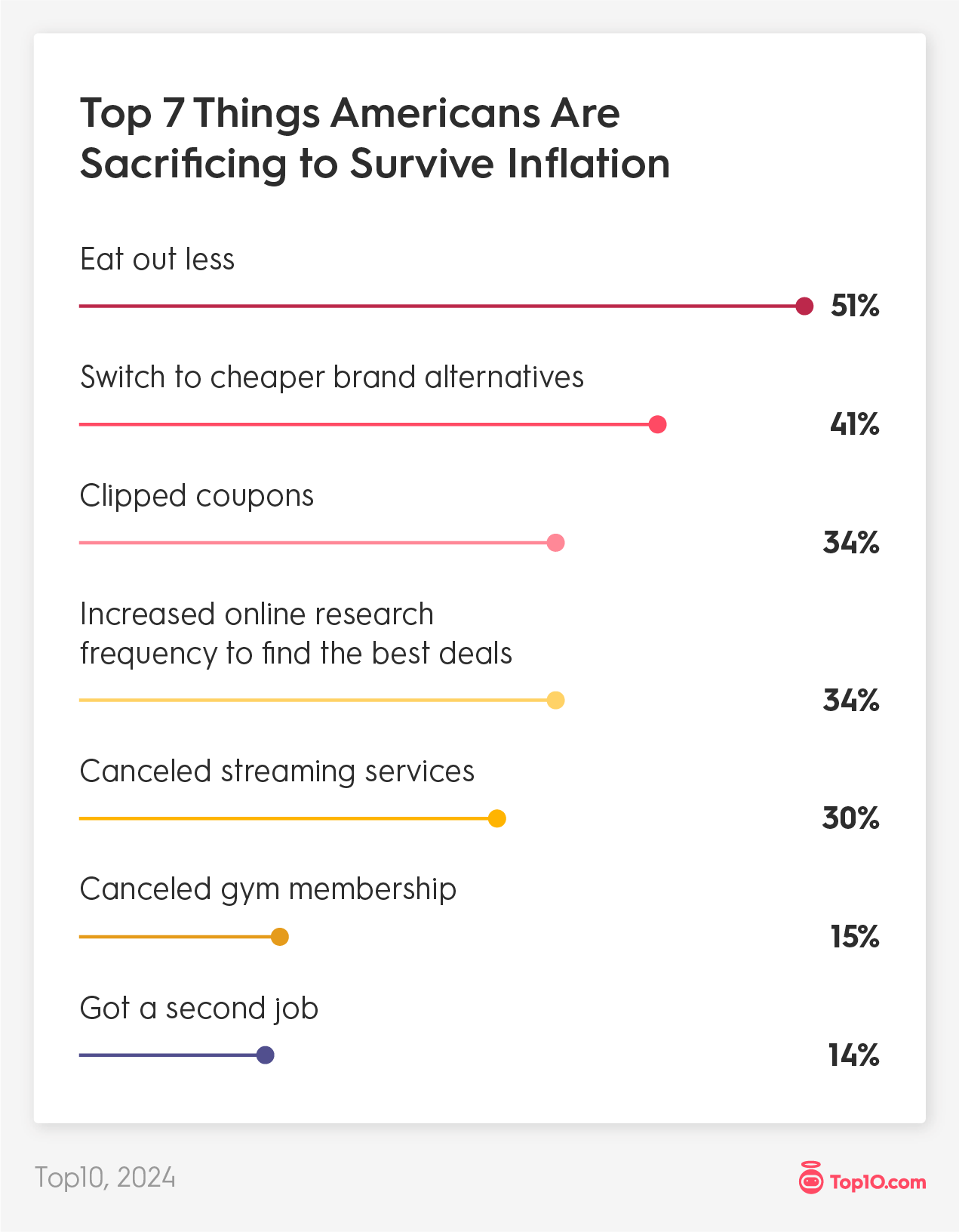
Other popular tactics among survey respondents include:
- Clipping coupons (34%)
- Canceling streaming services (30%)
- Increasing online research to find the best deals (34%)
As a result of the challenges brought on by inflation and the rising cost of living, 3 in 10 people feel their lives are slightly worse.
Boomers Are 5x More Willing To Give Up Safety Than Proximity to Friends and Family To Save Money
When selecting where they want to live, we found that proximity to friends and family was the biggest consideration for 19% of Americans. Cost of living and safety tied for second on the list of top priorities, both with 16%.
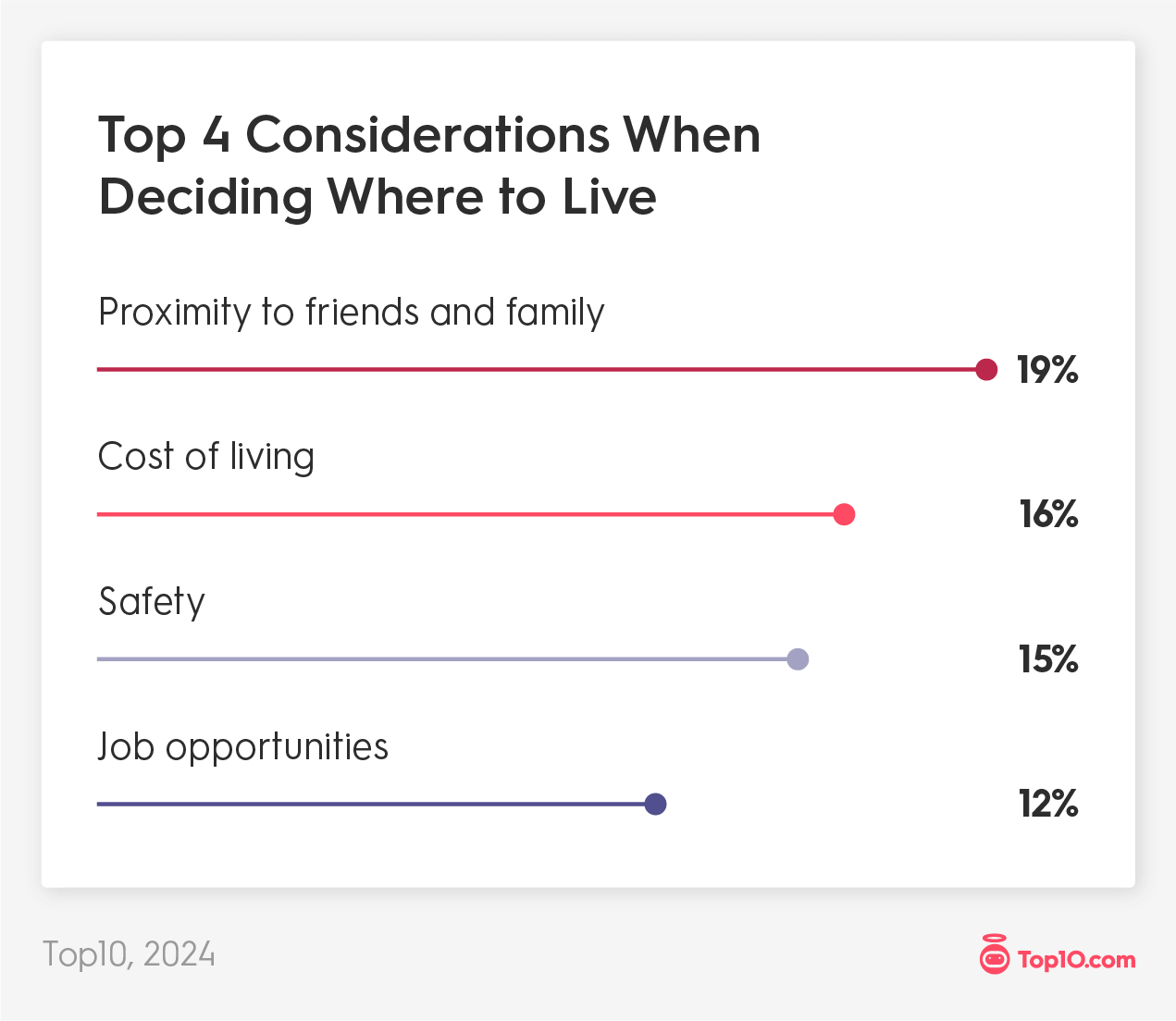
Upon looking at the results according to age, 34% of Baby Boomers felt it was critical to have their friends and family close. Compare that to only 14% of Gen Z, Millennials, and Gen X who felt the same.
In contrast, safety was the highest priority to consider for 19% of Gen Z, 19% of Millennials, 17% of Gen X, and only 7% of Boomers.
31% of Gen Zers Would Sacrifice Having Friends and Family Close in Favor of Moving Somewhere Cheaper
Keeping their grandkids close is a top priority for Baby Boomers based on responses to the question of which factor is more important for choosing where to live. But, when asked which sacrifices they would be willing to tolerate to move to a less expensive locale, 28% of the general public revealed that proximity to friends and family is the first thing they would give up.
In alignment with those findings, Gen Z is the most willing to move away from their loved ones. Millennials and Gen X are close behind. The generational breakdown was:
- Gen Z (31%)
- Millennials (30%)
- Gen X (30%)
- Boomers (21%)

Boomers were found to be the most unwilling to risk a change in their community’s political alignment, with 88% saying they wouldn’t take the chance. With only 12% of solder adults willing, it’s interesting to note that 27% of Gen Z, 22% of Millennials, and 22% of Gen X were willing to risk a change in local political alignment.
Almost 1 in 4 (24%) people asserted they would never be willing to move to a less expensive locale. But many others found sacrifices for savings acceptable, including:
- Less access to public transit (25%)
- Change in the community’s political alignment (20%)
- Less career growth (17%)
- Worse climate (17%)
42% of Gen Xers Refuse To Sell Belongings To Save Money When Moving
With transportation services—including the moving industry—experiencing a rise in the consumer price index of over 11% within the past year, concerns about the cost of a big move are only natural. We asked if people would plan to sell off or donate some or all of their belongings.
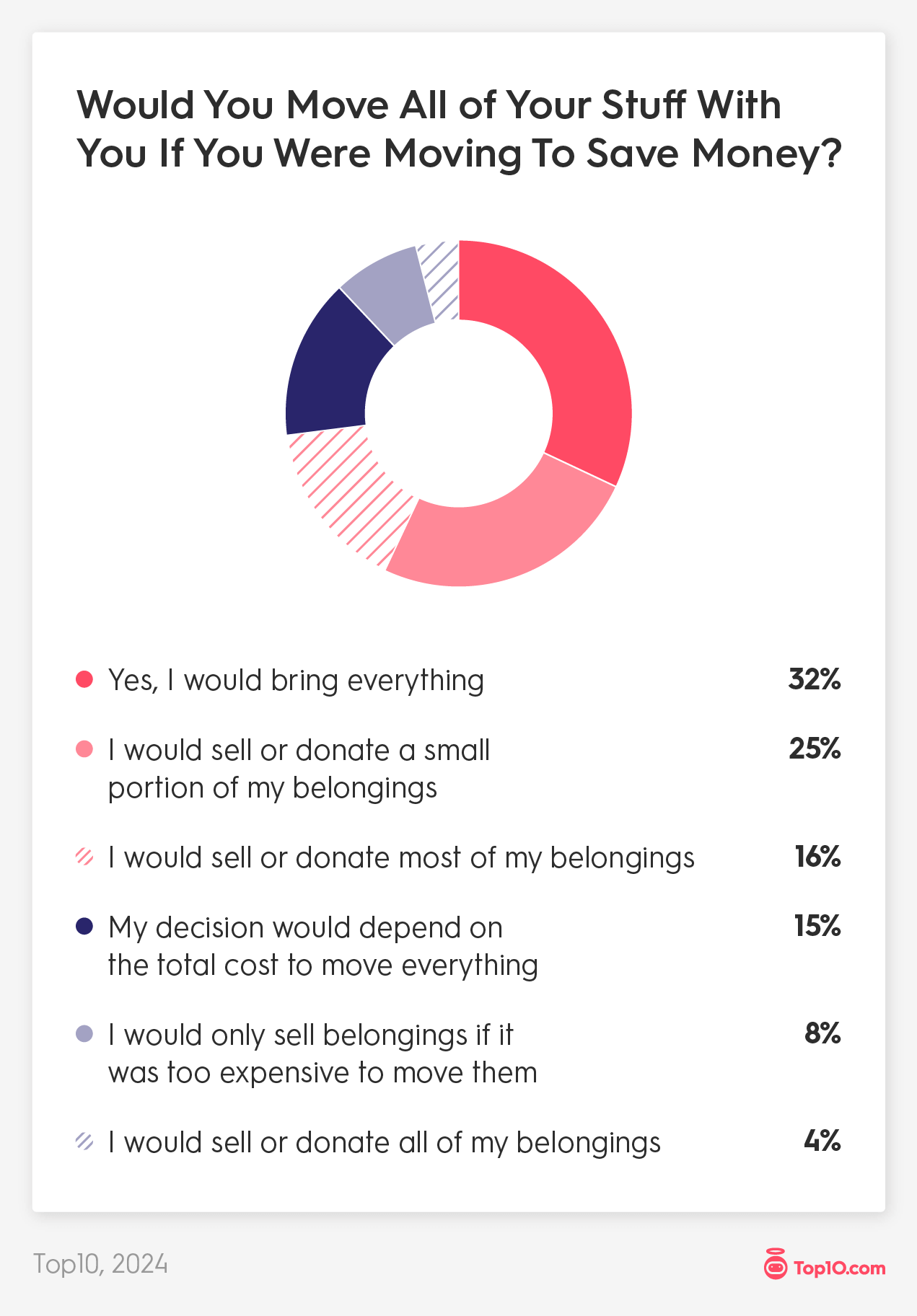
Thirty-two percent said they would bring everything with them. Gen X felt especially strongly about holding onto all of their belongings, with 42% of them stating they would go that route. In comparison, 27% of Gen Z, 34% of Millennials, and 21% of Boomers felt the same way.
We also inquired about the public’s concerns about the cost of the move itself and how it may influence their decision to move, with 30% saying it slightly discouraged them and 32% feeling moderately discouraged. Baby Boomers were the most worried about the cost, as 22% said their decision to move would depend on the total cost to move everything.
Make Sure You Hire the Right Company if You’re Planning a Move
So, if you've crunched the numbers, reviewed your moving checklist, and determined that a cross-country move to a more affordable location seems like a sound strategy, congratulations! Now comes the not-so-glamorous part: the actual move itself.
Packing, organizing logistics, and transporting your belongings across vast distances can be a daunting task. This is where a reputable moving company comes in. They can take the stress out of the equation, ensuring a smooth and efficient relocation process.
Methodology
The survey of 1,035 adults aged 18+ was conducted via SurveyMonkey Audience for Top10 on May 7, 2024. Data is unweighted, and the margin of error is approximately +/-3% for the overall sample, with a 95% confidence level.
For cost of living rankings, state results from the Missouri Economic Research and Information Center were combined and averaged to determine regional rankings. We sorted the states for this comparison into the following regions:
South Atlantic
- Florida
- Georgia
- North Carolina
- South Carolina
- Virginia
- West Virginia
West South Central
- Arkansas
- Louisiana
- Oklahoma
- Texas
East South Central
- Alabama
- Kentucky
- Mississippi
- Tennessee
West North Central
- Iowa
- Kansas
- Minnesota
- Missouri
- Nebraska
- North Dakota
- South Dakota
Mountain
- Arizona
- Colorado
- Idaho
- Montana
- Nevada
- New Mexico
- Utah
- Wyoming
East North Central
- Illinois
- Indiana
- Michigan
- Ohio
- Wisconsin
Middle Atlantic
- Delaware
- Washington, D.C.
- Maryland
- New Jersey
- New York
- Pennsylvania
Pacific
- Alaska
- California
- Hawaii
- Oregon
- Washington
New England
- Connecticut
- Maine
- Massachusetts
- New Hampshire
- Rhode Island
- Vermont
As a Top10 writer, LiCalsi applies his real estate and relocation expertise to thoroughly explore moving services. He offers practical advice rooted in first-hand experience to help simplify moving complexities. His writing aims to clarify the moving process with straightforward, actionable tips.
